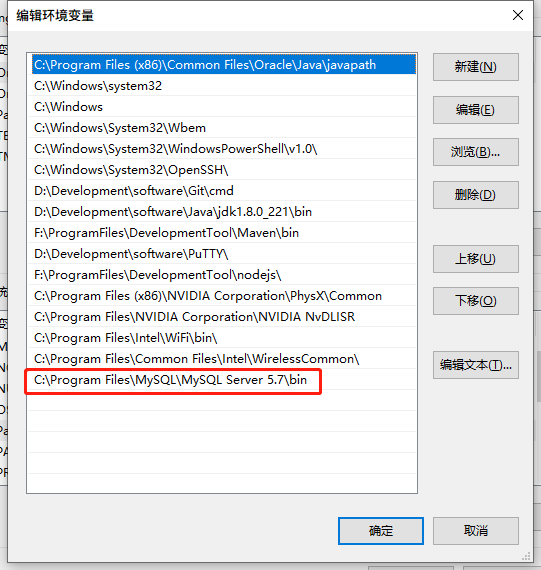网站备份常常是很有必要的,备份的方式有很多。之前不懂怎么备份,网上查了一下,看看怎么通过Java程序执行备份cmd命令,再结合solo的实现,自己的毕设也算是实现了这样的功能。solo用的是Latke的一个工具类Execs,但是我在用这个工具类的时候,可以ping,但是就是不能做执行备份的cmd命令,可能是自己使用的姿势不对,所以索性自己给改改。
2020-05-10更新
命令需要加上cmd /c,完整命令为
1
| String cmd = "cmd /c mysqldump -u" + dbUser + " -p" + dbPwd + " -hlocalhost --set-charset=utf8 --databases " + databaseName;
|
准备
导出是参看了solo的,压缩成zip包再响应前端,压缩用到了一个工具类:jodd-core-5.0.12.jar,下载地址:https://mvnrepository.com/artifact/org.jodd/jodd-core,
需要将MySQL的bin配置到环境变量中

JSP
我这里主要就是一个a标签。
1
| <a href="exportSQL">导出数据库</a>
|
Controller
1
2
3
4
5
6
7
|
@Value("#{configProperties['jdbc.username']}")
private String dbUser;
@Value("#{configProperties['jdbc.password']}")
private String dbPwd;
@Value("#{configProperties['jdbc.url']}")
private String dbURL;
|
这里连接数据库,是通过jdbc.properties文件得到的,获取值如上。
1
2
3
4
5
6
7
8
9
10
11
12
13
14
15
16
17
18
19
20
21
22
23
24
25
26
27
28
29
30
31
32
33
34
35
36
37
38
39
40
41
42
43
44
45
46
47
48
49
50
51
52
53
54
55
56
57
58
59
60
|
@RequestMapping("/exportSQL")
@ResponseBody
public void exportSQL(HttpServletRequest request, HttpServletResponse response) throws FileNotFoundException, IOException {
int beginIndex = dbURL.lastIndexOf("/") + 1;
int endIndex = dbURL.indexOf("?");
String databaseName = dbURL.substring(beginIndex, endIndex);
String cmd = "mysqldump -u" + dbUser + " -p" + dbPwd + " -hlocalhost --set-charset=utf8 --databases " + databaseName;
try {
Runtime runtime = Runtime.getRuntime();
Process child = runtime.exec(cmd);
InputStream in = child.getInputStream();
InputStreamReader xx = new InputStreamReader(in, "utf8");
String inStr;
StringBuffer sb = new StringBuffer("");
String outStr;
BufferedReader br = new BufferedReader(xx);
while ((inStr = br.readLine()) != null) {
sb.append(inStr + "\r\n");
}
outStr = sb.toString();
String tmpDir = System.getProperty("java.io.tmpdir");
String date = DateFormatUtil.getStringTime();
String localFilePath = tmpDir + "db_shms-" + date + ".sql";
File localFile = new File(localFilePath);
byte[] data = outStr.getBytes("UTF-8");
try (final OutputStream output = new FileOutputStream(localFile)) {
IOUtils.write(data, output);
}
File zipFile = ZipUtil.zip(localFile);
byte[] zipData;
try (final FileInputStream inputStream = new FileInputStream(zipFile)) {
zipData = IOUtils.toByteArray(inputStream);
}
response.setContentType("application/zip");
final String fileName = "db_shms-" + date + ".zip";
response.setHeader("Content-Disposition", "attachment; filename=\"" + fileName + "\"");
final ServletOutputStream outputStream = response.getOutputStream();
outputStream.write(zipData);
in.close();
xx.close();
br.close();
outputStream.flush();
outputStream.close();
localFile.delete();
zipFile.delete();
} catch (Exception e) {
e.printStackTrace();
}
}
|
需要注意的就是cmd命令,在哪些地方需要空格,哪里不需要空格,毕竟是命令,关系到导出是否成功。
关于mysqldump命令的详细参数,可以看这个https://www.cnblogs.com/liuriqi/p/4207310.html
XML配置
这里主要就是在applicationContext.xml配置properties文件。
1
2
3
4
5
6
| xmlns:util="http://www.springframework.org/schema/util"
xsi:schemaLocation="http://www.springframework.org/schema/util
http://www.springframework.org/schema/util/spring-util.xsd">
<util:properties id="configProperties" location="classpath:jdbc.properties" />
|
这样,在Controller就能通过@Value 注解获得配置文件的相应参数值。至于jdbc.properties文件,这里就不写了,就是数据库配置的properties文件。

